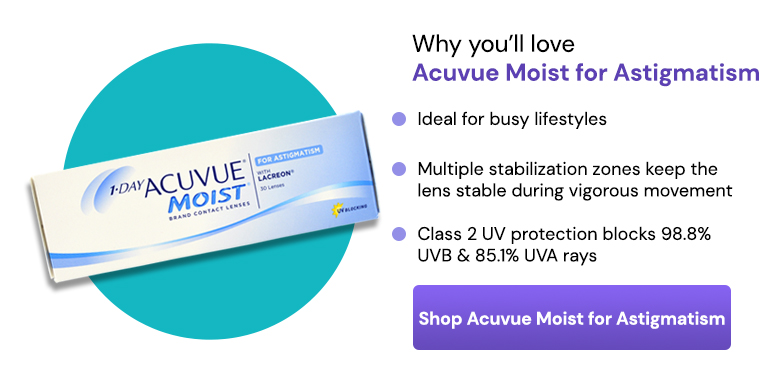The Ultimate Guide to Astigmatism
What Is Astigmatism?
Affecting one or both eyes, astigmatism is a condition that can cause several visual distortions such as blurriness or streaking and occurs due to an imperfection in the curvature of the cornea or lens, which then affects the way light enters your eye.
It’s common for those suffering from astigmatism to also experience myopia (near-sightedness) or hyperopia (far-sightedness). These three conditions are referred to as refractive errors because they influence how the eyes bend or “refract” light.
Types of astigmatism
The two main types of astigmatism are defined by the part of your eye that is misshapen to cause the refractive error.
Corneal astigmatism
Corneal astigmatism occurs when your cornea (the clear front part of the eye) is misshapen. Depending on the severity of the astigmatism, the cornea takes the shape of an egg or a rugby ball, rather than the regular round shape. This type of astigmatism is the most common form.
Lenticular astigmatism
Lenticular astigmatism is caused when the lens in the eye is shaped irregularly.
Both types cause blurry vision, and in severe cases of astigmatism, distorted vision.
What Causes Astigmatism?
Astigmatism is part of a group of eye conditions known as refractive errors. Other members of this group include myopia, hypermetropia and presbyopia.
This condition can be described as corneal or lenticular. The corneal kind is the more common of the two, and it simply means your cornea is not perfectly curved. Similarly, if your lens is irregularly curved, it’s referred to as lenticular astigmatism.
While there are many different causes of astigmatism, the most common is heredity. It will often run in the family and be present at birth, developing as you age. Almost all of us have it to some degree, although mild cases of astigmatism may not require treatment.
The refractive error can be present either at birth and remain unnoticeable during life or intensify at a later age, or it can be developed after an eye injury, eye disease or eye surgery.
Scarring or injury
An eye injury can scar the cornea, which changes its shape to cause an astigmatism or worsen the effect of one that is already pre-existent. This is also the case if an eye surgery causes scarring on the eye.
Eye Diseases
Certain diseases can also cause the cornea to deform, leading to an astigmatism. An example of this is keratoconus, which is a disease that causes the cornea to slowly grow thinner over time.
Who is at risk?
Both children and adults can be affected by astigmatism. It can be present at birth or develop at a later age.
Children
A lot of newborns have astigmatic eyes during their first year after birth. It is a simple irregularity in the structure of their eyes that regulates itself as their bodies grow. Paediatricians typically perform screenings during check-up appointments to ensure the child’s eye health is developing properly. These are especially important, as high astigmatism that is not spotted early on can cause lazy eye in children.
Adults
Depending on the severity of the astigmatism, most adults might not even notice the refractive error. However, if the astigmatism is noticeably causing distorted vision, this can easily be corrected with glasses or prescription contact lenses.
Symptoms
Astigmatism can have varying symptoms, depending on the severity. It might not affect the vision of those with low astigmatism at all, while those with higher astigmatism might experience several symptoms, from vision changes to headaches.
How to tell if you have astigmatism
Often occurring in tandem with myopia (nearsightedness) or hypermetropia (long-sightedness), the most common symptom is blurred vision, but you may also experience:
- Headaches
- Squinting (to focus on text or objects)
- Eye strain (especially when focusing for long periods of time)
If you are experiencing the above, check in with your optician as it could be linked to another condition.
Is the progression of astigmatism preventable?
If you are born with astigmatism, or it is genetically inherited, it cannot be prevented. However, you can protect your eyes from injury, as scarring may also cause the astigmatism.
Protecting your eyes
Most eye injuries happen either during work or at home, but they can easily be prevented.
If you are working in an environment where flying dust or particles are a common occurrence, it is important to always wear safety glasses or goggles to protect your eyes. The same goes for work with chemicals, as the fumes can affect the tear-film of your eyes.
When you are gardening or cooking, always be careful around branches or hot grease that could enter your eyes and cause harm.
If you ever notice sudden pain or trouble opening or seeing out of one of your eyes, you should seek medical help immediately.
How can you treat astigmatism?
If astigmatism is slight, people often do not need treatment for it, but when it starts to impact your vision significantly, an eye examination needs to be completed for a definitive diagnosis. This eye condition can easily be corrected by corrective lenses or laser surgery, which can be determined by a doctor.
Corrective lenses can be prescribed to people suffering from astigmatism, with the glasses designed to be curved to counterbalance the corneal irregularity that causes blurred vision. They work well when looking straight ahead, but depending on how much correction is needed, they may make the wall or floor look tilted.
Contact lenses can also be used to treat astigmatism, with doctor’s and eye experts typically recommending toric lens or rigid gas-permeable (RGP) throughout the day. Toric contact lenses are soft contact lenses that compensate for the individual differences in the shape of your eye, enabling light to focus correctly on your retina. This type of lens can also rotate on the front of the eye to find the perfect angle.
RGP, on the other hand, does not conform to the surface as soft lenses do. They are rigid and help to correct the eye's uneven surface. Unlike other contacts, these have a thicker zone at the bottom to stop the lens from rotating while in the eye.
Once the curvature is evened out, the lenses will still need to be worn to maintain the new shape but less frequently. It is possible for curvature correction to disappear and for the cornea to revert to its abnormal shape, making it important for people to wear the lenses for a long period of time to preserve the benefits of the procedure.
Laser eye surgery, also known as LASIK, can help to reshape the cornea so that it can focus on light rays better. This works by making a thin flap in the cornea, which is replaced after using a laser to reshape it.
If you are experiencing symptoms such as blurred or distorted vision, eye strain or discomfort, headaches or squinting, it is recommended that you speak to your optician. They will be able to detect and diagnose astigmatism and help you find the best treatment to fit your lifestyle and needs.




